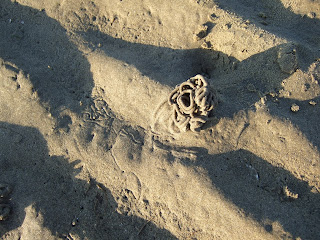This summer I went on an amazing bronze casting course in South Wales, run by two friends. I feel so lucky to know them - and to have had a chance to go and learn this very ancient process. They have been established for a few years now and Mark had made a new furnace out of a large gas cylinder especially for this year's workshop.
I arrived a bit early and helped out with preparations, plus set up my enormous tent (kindly lent by Mark and Caroline). The neighbours seemed friendly.
The barns and communal areas house workshops, casting areas and examples of bronzes from the New British Art library of objects. Lots of food for thought.
 |
| A few objects from the library |
 |
| Vole nest found in the farm by Mark - a functional, beautiful object. |
The workshop was five days long, and started with creating objects in soft wax. The wax became beautifully malleable after being handled for a few minutes. If it got too soft, it could be immersed in cold water to harden it.
 |
| Moulding waxes in the workshop |
After creating the wax objects, the next stage is to attach them to a wax cup by a sprue. If the object is complex it might need risers too. Mark gave advice on this as we went along.
After attaching the objects to the wax cups the whole wax form was de-greased with an alcohol and shellac mixture, dried, then coated in a colloidal silica/molochite suspension. This gave a gluey first coating which was then dusted in molochite powder and allowed to dry.
 |
| Looking from the workshop to the foundry |
 |
| Waxes coated in layers of porcelain and drying off, ready to be burned out. |
 |
| Shells drying - imitating sea creatures or fossils |
This process was repeated several times with coarser grains of molochite, so that a very hard shell was formed around the wax.
 |
| Casting area with de-greasing agent and Molochite |
 |
| Burning out the wax from the shells |
Then the waxes were burned out in the furnace - note the flaming wax dripping from the barrel! This stage was dramatic... especially with the sound of the gas feeding the flames. Mark had welded on a pipe to feed the flames with air. When I turned the gas on the pipe created a singing note - the flame was not reaching the furnace - so Mark would kick-start the suction again by briefly covering the hole with a (gauntleted) hand.
 |
| Shells ready for casting |
The results of burning out the wax - empty shells, cooling on a kiln blanket.
My new friends and I took a trip to the local beach. It was a gorgeous evening. Mark had told us about boulders there that were partially iron - from the bottoms of blast furnaces... eventually we found them.
 |
| stones are rusting -they are the bases of blast furnaces! |
...some other casts.
Then on the Thursday Mark and Jim poured the final casts. This was the highlight of the week - tense and then amazing to see our pieces in metal.

The heat was incredible even from ten feet away, and the pieces stayed hot for some time even after being submerged in the water trough.

Partially-revealed casts
All that was left was to bash away the hardened shells and cut the pieces from the sprues. It was surprisingly hard work - the vitrified shells were very tough to remove. To get in between we needed chisels and wire brushes.
|
Tiny casts!
My next adventure is to try patinating them - I'm keen to try ammonia, which reacts with the copper to turn it bright blue.. will update when I have pictures!





























No comments:
Post a Comment